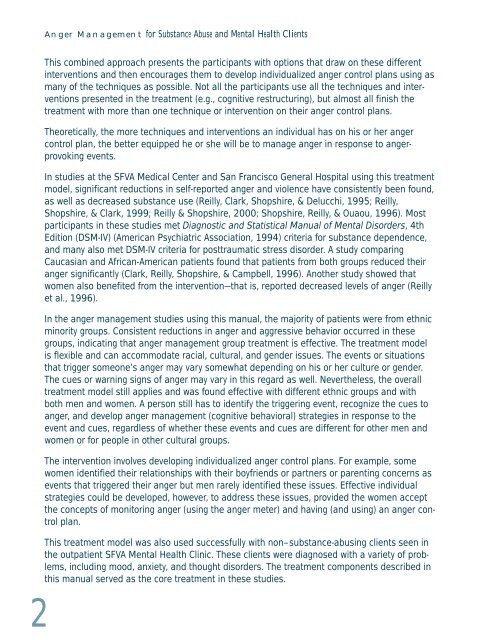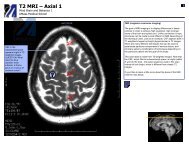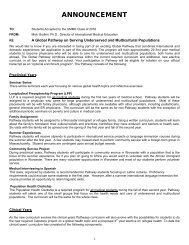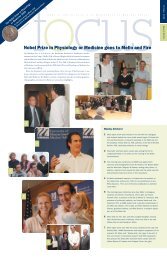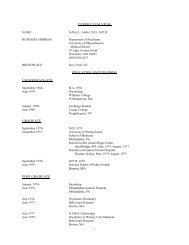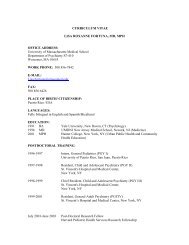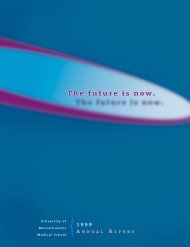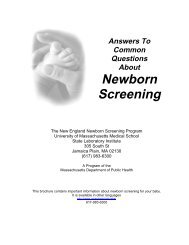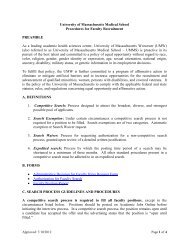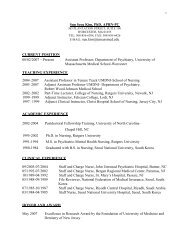Anger Management Manual - the ATTC Network
Anger Management Manual - the ATTC Network
Anger Management Manual - the ATTC Network
You also want an ePaper? Increase the reach of your titles
YUMPU automatically turns print PDFs into web optimized ePapers that Google loves.
<strong>Anger</strong> <strong>Management</strong> for Substance Abuse and Mental Health Clients<br />
This combined approach presents <strong>the</strong> participants with options that draw on <strong>the</strong>se different<br />
interventions and <strong>the</strong>n encourages <strong>the</strong>m to develop individualized anger control plans using as<br />
many of <strong>the</strong> techniques as possible. Not all <strong>the</strong> participants use all <strong>the</strong> techniques and interventions<br />
presented in <strong>the</strong> treatment (e.g., cognitive restructuring), but almost all finish <strong>the</strong><br />
treatment with more than one technique or intervention on <strong>the</strong>ir anger control plans.<br />
Theoretically, <strong>the</strong> more techniques and interventions an individual has on his or her anger<br />
control plan, <strong>the</strong> better equipped he or she will be to manage anger in response to angerprovoking<br />
events.<br />
In studies at <strong>the</strong> SFVA Medical Center and San Francisco General Hospital using this treatment<br />
model, significant reductions in self-reported anger and violence have consistently been found,<br />
as well as decreased substance use (Reilly, Clark, Shopshire, & Delucchi, 1995; Reilly,<br />
Shopshire, & Clark, 1999; Reilly & Shopshire, 2000; Shopshire, Reilly, & Ouaou, 1996). Most<br />
participants in <strong>the</strong>se studies met Diagnostic and Statistical <strong>Manual</strong> of Mental Disorders, 4th<br />
Edition (DSM-IV) (American Psychiatric Association, 1994) criteria for substance dependence,<br />
and many also met DSM-IV criteria for posttraumatic stress disorder. A study comparing<br />
Caucasian and African-American patients found that patients from both groups reduced <strong>the</strong>ir<br />
anger significantly (Clark, Reilly, Shopshire, & Campbell, 1996). Ano<strong>the</strong>r study showed that<br />
women also benefited from <strong>the</strong> intervention—that is, reported decreased levels of anger (Reilly<br />
et al., 1996).<br />
In <strong>the</strong> anger management studies using this manual, <strong>the</strong> majority of patients were from ethnic<br />
minority groups. Consistent reductions in anger and aggressive behavior occurred in <strong>the</strong>se<br />
groups, indicating that anger management group treatment is effective. The treatment model<br />
is flexible and can accommodate racial, cultural, and gender issues. The events or situations<br />
that trigger someone’s anger may vary somewhat depending on his or her culture or gender.<br />
The cues or warning signs of anger may vary in this regard as well. Never<strong>the</strong>less, <strong>the</strong> overall<br />
treatment model still applies and was found effective with different ethnic groups and with<br />
both men and women. A person still has to identify <strong>the</strong> triggering event, recognize <strong>the</strong> cues to<br />
anger, and develop anger management (cognitive behavioral) strategies in response to <strong>the</strong><br />
event and cues, regardless of whe<strong>the</strong>r <strong>the</strong>se events and cues are different for o<strong>the</strong>r men and<br />
women or for people in o<strong>the</strong>r cultural groups.<br />
The intervention involves developing individualized anger control plans. For example, some<br />
women identified <strong>the</strong>ir relationships with <strong>the</strong>ir boyfriends or partners or parenting concerns as<br />
events that triggered <strong>the</strong>ir anger but men rarely identified <strong>the</strong>se issues. Effective individual<br />
strategies could be developed, however, to address <strong>the</strong>se issues, provided <strong>the</strong> women accept<br />
<strong>the</strong> concepts of monitoring anger (using <strong>the</strong> anger meter) and having (and using) an anger control<br />
plan.<br />
This treatment model was also used successfully with non–substance-abusing clients seen in<br />
<strong>the</strong> outpatient SFVA Mental Health Clinic. These clients were diagnosed with a variety of problems,<br />
including mood, anxiety, and thought disorders. The treatment components described in<br />
this manual served as <strong>the</strong> core treatment in <strong>the</strong>se studies.<br />
2


